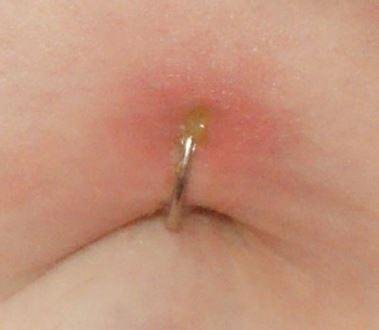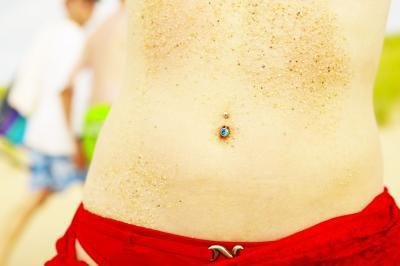What is Belly Button Piercing
Body piercing has since time immemorial been a way to express fashion statement while for some individuals, it is simply an ornament of beauty. Belly button piercing also referred to as navel piercing had become popular from long time ago and is still trending today. In as much as it is an adornment, it may have adverse effects if proper care is not maintained.

Fig. 1 navel piercing
What does Belly Button Piercing entail?
Before going to what takes place at the piercer’s office, it is important that you understand what to consider when selecting the place to get the piercing.
- First of all you should only chose a licensed shop where autoclave sterilization is conducted and hygiene is emphasized
- Secondly, ensure that the chair where the piercing will take place is covered with either paper or plastic, which ensures that you will not be exposed to body fluids of other clients
- A dispenser and sink should come third in your prioritization list and is an evident that the service you will get is top notch. Check out for those features and you will have your piercing stress free.
The procedure followed during navel piercing entails:
Step 1: If you have chosen a piercing shop that meets the standards, you will notice the piercer cleaning his or her hands and then putting on surgical gloves before attending to you.
Step 2: The navel and the surrounding skin is cleansed with surgical wash to keep the area sterilized. If you are concerned about the pain, you can ask for topical anesthetics to be included for that matter.
Step 3: Skin around the navel is pinched and then pierced using a surgical needle and the belly ring is threaded along with it. It is then fixed into place. In some cases, a square or star shape is made when piercing both lower and upper navel lips. Depending on preference, two or more surface piercings may be done. At this stage, you might feel some pain.
Step 4: Just like the first step, the belly button is given a surgical wash and patted dry. After this you will be free to go.
Complications Associated with Belly Button Piercing
Navel piercing adorns your mid-section but can pose various health risks if you are not careful. Some complications that may result include:
- Bacterial infection– if proper hygiene is not maintained
- Tearing– this is caused when the belly ring gets caught into something, say a fabric and is pulled or tagged
- Excessive bleeding– caused in the case of ‘outie’ belly button piercing since blood vessels are numerous on that site
- Scarring– usually takes place following trauma such as tear caused when removing clothes
- Irritation– some people may be allergic to some metals, which result into allergic reactions.
Bacterial Infection
This is the most common health risk associated with belly rings because the navel/belly button is always subject to sweat and warmth, which provides a breeding ground for bacteria. There are other factors, which encourage the spread of this type of infection, some include:
- Underlying medical conditions such as diabetes
- Low immune system
- Piercing done with unsterilized equipment
Signs of Infection
You can tell that your belly ring has been infected when:
- The surrounding skin becomes red, irritated and is warm to touch
- Yellowish green fluid that looks like pus is discharged instead of the clear fluid that normally leaks
- Formation of bubbles and bumps
- Some itchy rashes forming on the skin surrounding of the piercing
- A navel piercing hole that is enlarging
- Painful sensation at the piercing site
- Piercing bleeds
- You may experience fever, throwing up, stomach aches and even dizziness.

Fig.2 An infection after piercing the belly-button
Scarring
If a piercing is subjected to trauma such as tear or improper after care, hypertrophic or keloid scars may develop. These scars can also form if you are a sporty kind of person due to high activity. Hypertrophic scars may improve over time but it surely will remain. 3

Fig.3 Scarring caused by belly rings
Irritation
Some people cannot use just any material for piercing jewelry because they may get allergic reactions. Irritation can be characterized by formation of itchy rashes on the area around the piercing and you may experience discomfort. Materials that could serve as good jewelry include:
- Gold– both classy and attractive alternative but bends during warm conditions, so if you like long hours of basking under the sun at the beach, this is definitely not your cup of tea.
- Tygon plastic– if you are allergic to metals this may be the best option for you.
- Surgical titanium– this material is used for dentures implants and if it can withstand saliva then it can pretty much stand anything.
- Stainless steel (surgical) – is the best material as it does not cause any reactions and it does not deteriorate.
After-care
If you want to enjoy your new piercing, then you have to pay extra attention to your belly button. That way, irritations, infections and scarring will be kept at bay.
- Clean your hands thoroughly before handling the piercing. This prevents infection
- Clean the piercing site twice a day using soap and water. While at it, ensure that there is little to no movement of the jewelry. Wash cloths, towels or loofahs should be avoided as they may be sites for bacteria and can also cause tearing if they get entangled with the piercing. Use a paper towel to pat dry the site, you should never rub it.
- Keeping the piercing site clean is important but doing it in excess is detrimental to the healing process.
- As tempting as it is, avoid playing with your new belly ring since movement enhances irritation.
- Once you get a navel piercing, public baths or swimming pools should be avoided until the piercing heals completely (from 6 to 12 months).
- If you are pregnant, you can keep the piercing on up to the 6th month but after that ensure to remove it. A couple of months after postpartum that’s when you can put it on. For infections, get early treatment before the pregnancy progresses and you are unable to take antibiotics that may harm the baby (if taken at that stage).
- Crusties should be removed gently. Lymph is usually produced after piercing which when dries up form white crystal like substances (crusties). Previously, clients were advised to move the belly rings to dislodge them but nowadays this is considered a cause for infection. Instead, you should use cotton swabs dipped in warm water or sea water to soften the crusties and then wipe them clean.
- Oil, ointments and creams should be avoided as they could obstruct the piercing hole providing a breeding site for bacteria. If the piercing is dry, add oil to salt water and soak. This will ensure moisturizing of the fistula.
Treatment
A patient may want to try out the following treatment options.
- Soak the piercing into sea salt water which has antiseptic properties. This will prevent infection.
- Conduct warm compresses on the piercing site which will enhance healing through drainage of fluids.
- Use a cold pack to relieve pain
- Oral antibiotics and pain relieving drugs may be prescribed by the doctor for infection treatment and alleviating of pain respectively.
- Purchase over the counter creams for scarring which can reduce the swelling and discoloration of the scars. In some cases surgical removal of fistulas could be done for large scars
- Tea tree oil can be added to the sea salt solution for moisturizing purposes as well as infection prevention and treatment.
Pictures


Reference List
- The Belly Button Piercing and Healing Process, available at http://info.painfulpleasures.com/help-center/piercing-information/belly-button-piercing-healing-process
- Navel Belly Button Piercing Infection Symptoms How to Treat and Clean, available at http://www.healcure.org/navel/button-belly-piercing/infected-belly-button-piercing-signs-bump-treatment-pictures-ring/
- Scars From Belly Rings, available at http://www.livestrong.com/article/294038-scars-from-belly-rings/
- Guide to Belly button piercing, available at http://tattoos.lovetoknow.com/Belly_Button_Piercing
- What You Need to Know About Belly-Button Piercing, available at http://www.livestrong.com/article/124134-navel-piercings/

Eu acho muito bonito e charmoso o piercing no umbigo